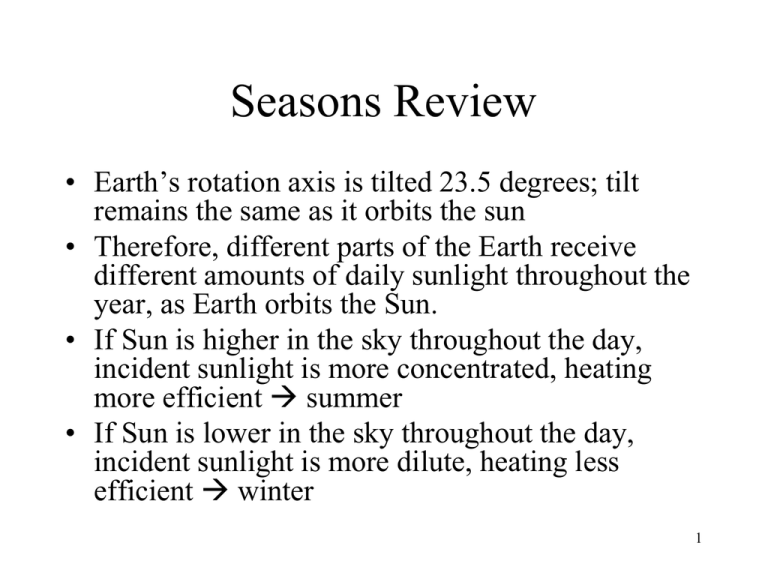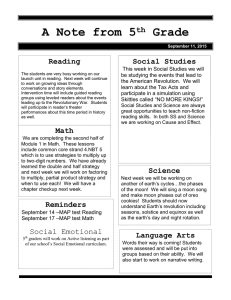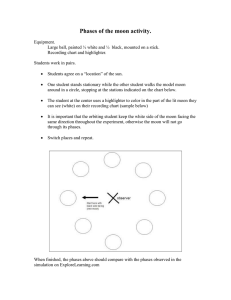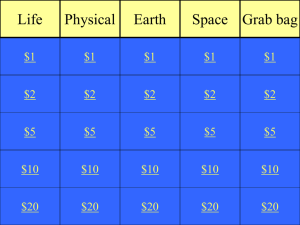Seasons Review
advertisement

Seasons Review • Earth’s rotation axis is tilted 23.5 degrees; tilt remains the same as it orbits the sun • Therefore, different parts of the Earth receive different amounts of daily sunlight throughout the year, as Earth orbits the Sun. • If Sun is higher in the sky throughout the day, incident sunlight is more concentrated, heating more efficient summer • If Sun is lower in the sky throughout the day, incident sunlight is more dilute, heating less efficient winter 1 Seasons Review • Equinoxes: Sun is on equator (ecliptic and celestial equator intersect); rises due East, sets due west – March: moving north – September: moving south – Equal daylight / night time • Solstices: Extreme North and South positions for Sun – June: farthest North (Tropic of Cancer, latitude +23.5), longest day – December: farthest South (Tropic of Capricorn, latitude -23.5), shortest day 2 Seasons Review • Antarctic circle (lat. = -(90-23.5) = -66.5 receives no sunlight on June Solstice • Arctic circle (lat. = +(90-23.5) = +66.5 receive no sunlight on December Solstice 3 Phases of the Moon • The Phases of the Moon are the variations in the Moon’s appearance as the Moon orbits the Earth. • They are due to the changing Sun-Earth-Moon angle through each month. • The following is the cycle of lunar phases: new, waxing crescent, first quarter, gibbous, full, gibbous, third quarter, waning crescent, new 4 Moon Phases • The Moon orbits the Earth in about one month (29.5 days) • Over one orbit the appearance and rise and set times change with the cycle of Lunar Phases. • The figure is not to scale 5 Light & Dark How the Earth and Moon would look high above Earth’s North Pole. The figure is not to scale. • We only see the Moon because sunlight reflects off its surface. • At any one time, half the Moon is always lit and half is in darkness. • The amount of the illuminated half we see from Earth depends on the position of the Moon in its orbit • The time of day the Moon is visible also depends on its phase. 6 Example: Observing the Moon • Between September 10-11, at dusk, the Moon will be visible in its waxing crescent phase. • The first night it appeared close to the Sun. Subsequent nights it will appear higher in the sky (farther from the Sun) and the lit portion appeared to be growing larger. • What do you think you would see the next night? How about a week later? 7 The Moon Rises Later Each Day 8 Lunar Phase Terms • The cycle of Lunar Phases starts at the New Moon. • At New Moon the Moon is not visible to us on Earth. • From New Moon to Full Moon the illuminated fraction of the Moon we see from Earth grows. It is said to be waxing. • After Full Moon the fraction of the illuminated We can only see the half of the Moon above and to the right of the Moon visible from Earth diagonal line drawn on the Moon shrinks. It is said to be waning. in the figure above. 9 The Cycle of Lunar Phases • The Lunar cycle is split into quarters – – – – New Moon 1st Quarter Full Moon 3rd (or Last) Quarter • Since the whole cycle lasts about a month each quarter lasts about a week. See http://kalender-365.de/lunar-calendar.php for more months. 10 As you view the moon from different directions (relative to the Sun) its appearance changes. 11 crosses meridian at sundown crosses meridian at about 9:00 pm crosses meridian at about 3:00 pm sunlight crosses meridian at midnight crosses meridian at noon sunlight crosses meridian at about 9:00 am crosses meridian at about 3:00 am crosses meridian at dawn 12 Phases of the Moon What Can You See http://kids.niehs.nih.gov/lunar/home.htm 13 Phases of the Moon When Can You See It 14 The Lunar Phases Web Tools • Lunar Phases -- University of NebraskaLincoln • Lunar Phases Interactive 15 Lunar Libration 16 Near and Far Sides of the Moon Robert Gendler, 1999 Apollo 16, 1972 17




